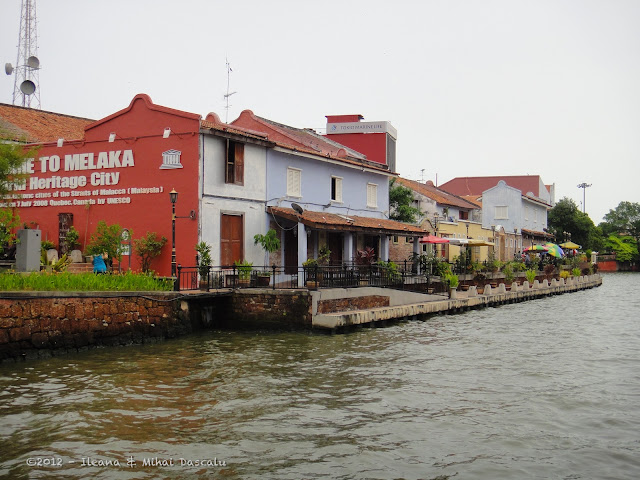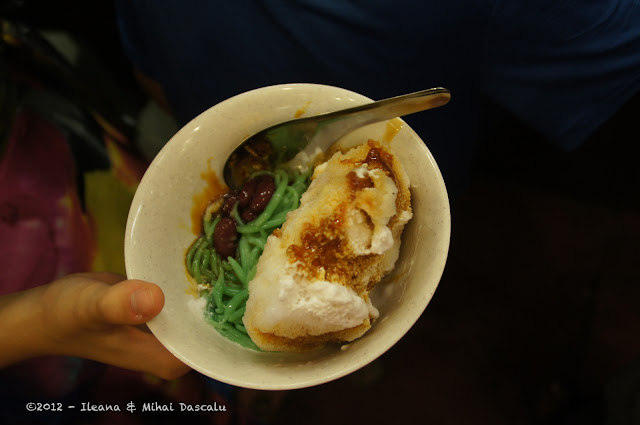Selamat datang! (seh-lah-mat dah-tong) Welcome to Malaysia!
It is a cloudy day and we’re looking for our bus to Melaka. The bus station is huge with at least 100 different parking spots for different buses. Inside there are food courts, bazaars and people, moving in all directions. We board our bus toward Melaka and nap almost all the way. Why are we here? Melaka is a World Heritage Site and we don’t need to be in Kuala Lumpur until Monday.
Flooded by Malaysians every week-end and vacation time, Melaka center is conveniently small and has all objectives in a walkable distance. It also has a Portuguese flavor mixed with a Dutch one. It was the place to be if you needed to cross the Indian Ocean and the monsoon was blowing. In 1500 it was a bustling place with trading businesses. Proof of its importance in the spice route are the fort walls, constructed by the Portuguese. They hoped to control the Asian market and they wanted to be prepared, to fight off the ones who would want it too. They made just one tiny mistake: they killed and sold the Muslim population into slavery. The Muslim traders just changed their routes, leaving them masters of a dying port. In a hundred years, the straits were conquered by the Dutch, who built some more, and some two hundred years later, they exchanged it for Sumatra with the British. In the 20th century it became part of Malaysia.
 |
| The gate to the A-Famosa Fort |
 |
| Many museums, one building. |
Now the string of the old buildings houses museums: of literature, of stamps, of the Muslim world, of beauty—twenty-four in total. On the streets around them there are rickshaws decorated garishly with plastic flowers and music blaring from huge loudspeakers. Some tourists pay money to be driven in them.
We cross the bridge to enter China Town, surveyed by a colorful and very long dragon.
We make our way toward the Dutch house. The split door is half-closed-half-open. The house is tiny, with whitewashed walls, an unadorned upstairs and a closed backyard/terrace. There is a bricked well at the ground level in which two golden fish are living. In the old days they would have been the proof that the water was safe to drink, today their role is to eat the mosquito larvae.
We make our way toward the Dutch house. The split door is half-closed-half-open. The house is tiny, with whitewashed walls, an unadorned upstairs and a closed backyard/terrace. There is a bricked well at the ground level in which two golden fish are living. In the old days they would have been the proof that the water was safe to drink, today their role is to eat the mosquito larvae.
 |
| Kitchen. |
The whole block is made of tiny houses, each with particular decorations.
One house is dubbed Malaccan house/museum, but actually it was an antiques shop. When we enter it the owner is showing something to some prospective clients.
On a small round table, the tea is getting cold in tiny cups. I smile as I recognize the way of doing business: you want something, but you don’t show it, you pretend being interested in something else, you inquire, you are shown, refuse, pretend to leave, you are called back, offered some tea, discuss some more, drink some more tea, until a satisfying price is reached for both parts. We look around and go from back room to back room, to a terrace, to something else, and it seems bottomless.
We return outside and almost don't notice the Baba Nyonya house.
One house is dubbed Malaccan house/museum, but actually it was an antiques shop. When we enter it the owner is showing something to some prospective clients.
On a small round table, the tea is getting cold in tiny cups. I smile as I recognize the way of doing business: you want something, but you don’t show it, you pretend being interested in something else, you inquire, you are shown, refuse, pretend to leave, you are called back, offered some tea, discuss some more, drink some more tea, until a satisfying price is reached for both parts. We look around and go from back room to back room, to a terrace, to something else, and it seems bottomless.
 |
| Three Chinese coins sewn with red silk. |
We return outside and almost don't notice the Baba Nyonya house.
It is said that a Chinese princess from the Ming dynasty came here to be married and she brought with her 500 men. These men married local women and their children grew speaking Malaysian. The man is called Baba and the woman Nyonya. Their culture is disappearing in a way, changed by the modern lifestyle. The rooms that we see are like frozen images of a different time. The parlor has ebony chairs encrusted with mother of pearl and the walls are covered in silk embroidered with animal scenes.
The parlor is separated from the rest of the house by a heavily sculpted ebony screen with translucent window panes. The women could not entertain guests, but they could see them through a tiny slit in the screen. We move up the stairs, beautifully carved under the steps, just to learn that it could be closed and locked like a box. This would help with a sneaky husband, and it stopped thieves, the guide tells us. The bedroom is behind a private living room. They slept in a four-poster bed covered in cloth, leaving just one side open. They didn’t have the convenience of running water, so the room doubled as a bathroom. In the floor there was a covered up hole. Apparently if an unwelcome guest would have shown up, the man of the house could spy through it, and if he really didn’t like him, he would have emptied the chamber pot over him!
 |
| These chairs were at the National Museum of Singapore. The "vase" on the floor is a chamber pot. |
Some wedding dresses are shown, silk with exquisite embroidery. They had to be worn over a rough shirt made of bamboo to protect them from sweat (they couldn’t be washed and they didn’t have dry cleaning).
In a different room there are exhibits pertaining to sickness (the house walls would have been decorated with black) or death (everything would be blue, including an embroidered shroud that would cover the coffer). Marriage or birthdays or new years would be red, with their gifts of money in red envelopes, noodles to symbolize long life, eggs to have children or grandchildren, sugar for sweetness of life.
 |
| Baba Nonya house |
As years passed by, the gramophone made its appearance, then the radio, and the decoration in the rooms changed, resembling an English one. They even had a fire extinguisher with a conical shape. We return downstairs to visit the once so-modern kitchen with white dishes for everyday use, colorful ones for feasts, or white and blue for a funeral. The museum belonged to the descendants of the family who started their married life in this house around 1900. There are a few pictures: one at the wedding, another with four children, with the grandchildren, and in 2010 just the descendants. We aren’t allowed to take pictures.
If this way of living seems out of place now, the nyonya cooking is still the same. We try some pineapple tarts (more like a shortbread with sticky jam) and cendol (send-all), red sweet beans, green noodles, with shaved ice, over which is laden coconut milk, sweetened with palm sugar.
As evening approaches the number of people rises. Touts were readying their wares, food stalls were preparing for the throngs of people who would flood the Chinese neighborhood in search for food and fun.
 |
| Reconstruction of a water wheel that used to distribute water to the traders. |
 |
| The oldest mosque in Malaysia. Notice the muezzin tower that looks more like a tiered pagoda. |
In a way it is alike and different from Penang, (listed together with Melaka as one World Heritage Site). We visited it right before flying to New Zealand. Alike, because they present the same mix of cultures—Chinese, Malay, Indian; same kind of buildings, same covered sidewalks that enable you to walk unimpeded by the rain. Different, because Malacca has a theme; it is small and organized. They stopped a modern project because they found a well and a corner of fortification, resurrected them, enlarged the area and put up some board notifications.
Christ Church and Stadhuyst have something in common with the town center; you almost expect to see a buggy with pilgrim—like people in it.
Penang is sprawled between modern buildings, businesses, criss-crossed by streets with heavy traffic, giving just bits and pieces that fail to have a connection. I know there are many people who liked Penang for the food and atmosphere, but maybe they didn’t visit Malacca.
Christ Church and Stadhuyst have something in common with the town center; you almost expect to see a buggy with pilgrim—like people in it.
 |
| Christ Church in the background, on the right side Stadhuyst, the city hall. |
Penang is sprawled between modern buildings, businesses, criss-crossed by streets with heavy traffic, giving just bits and pieces that fail to have a connection. I know there are many people who liked Penang for the food and atmosphere, but maybe they didn’t visit Malacca.
It is time to board another bus. Kuala Lumpur, here we come!
















